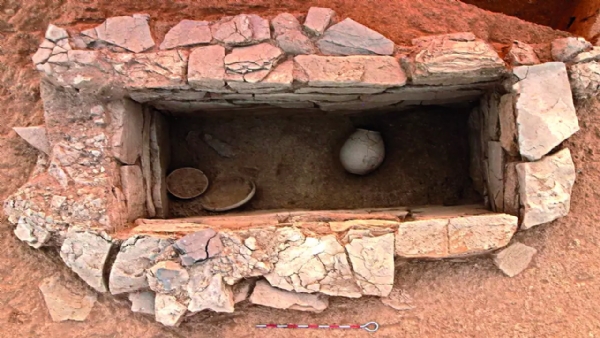This burial from Harappan site in Kutch dates back to 3200 BCE & is older than Dholavira; READ MORE:
Excavations at one of the biggest burial monuments of the Harappan period in Gujarat have resembled ancient humans buried when dead with afterlife items like personal artefacts, sacred animals, and pots of food and water.
Total Views |
Ahmedabad, Jan 9: In a recent archaeological excavation of Harappan sites that is being conducted in Gujarat's Kutch since considerable period, a monumental burial site dating back to 3200 BCE and seems to be older than Dholavira has been recovered.

Excavations at one of the biggest burial monuments of the Harappan period in Gujarat have resembled ancient humans buried when dead with afterlife items like personal artefacts, sacred animals, and pots of food and water - a civilizational gesture. The excavation began in 2019 at Juna Khatiya village, about 30km from Lakhpat in Kutch district, and archaeologists found rows of graves with skeletal remains, ceramic pots, plates and vases, beaded jewelry, and animal bones that attracted their interest.
The excavation continued resulting the site to emerge as one the biggest Harappan burial sites over time, with the possibility of 500 graves. Until now, out of the probable 500 graves, about 125 have been found so far. Interestingly, these graves have been dated back to a period between 3,200 BCE to 2,600 BCE, predating Dholavira—a UNESCO world heritage site—and several other Harappan sites in the state.
Burial site older than Dholavira in Gujarat, as old as 3200 BCE. The burials are aligned both east-west & north-south. https://t.co/Bq0Of4CJpc
— Indic History (@IndicHistory) January 8, 2023
As per the reports of TOI, this newly emerging site in Kutch is significant as the other sites like Dholavira have a cemetery in and around the town, but no major habitation has been discovered near Juna Khatiya, said Rajesh SV, excavation director and assistant professor of archaeology at University of Kerala. The site demonstrates the transition from earth-mound burials to stone graves. The pottery from the site have features and style similar to those excavated from early Harappan sites in Sindh and Balochistan. “The artefacts can put the site in perspective of other pre-urban Harappan sites in Gujarat,” said Rajesh.
According to the data recovered from the excavation, the rectangular graves were made of shale and sandstone, which are common rocks in the area, and other than items like clay bowls and dishes, prized possessions like beads and bangles of terracotta, seashells, and lapis lazuli were buried with the dead. “The majority of burial pits had five to six pots. In one, 62 pots were found. We have not found any metal artefact from the site so far,” said Rajesh. At a lecture delivered at IIT Gandhinagar last week, Rajesh said “Some of the burial structures have boulders of basalt as coverings. Pebbles of local rock, basalt, soil, sand, etc were used for construction, and clay was used to bind them together.”

